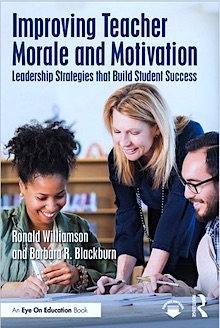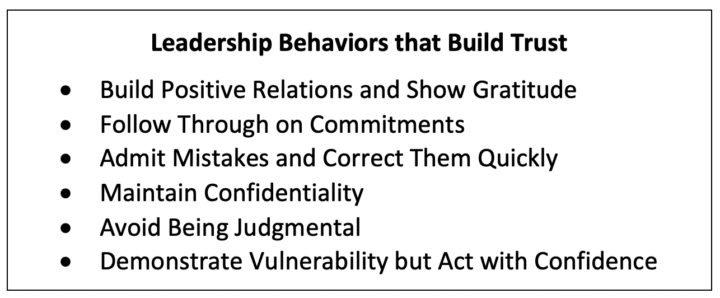6 Ways School Leaders Can Grow Teacher Trust
By Ronald Williamson and Barbara R. Blackburn
 Every time Ron taught a course on the principalship, he started by asking his adult students to describe a good school leader, the sort of person teachers and others would want to lead their school. Every semester the same response topped the list. They wanted a leader they could trust.
Every time Ron taught a course on the principalship, he started by asking his adult students to describe a good school leader, the sort of person teachers and others would want to lead their school. Every semester the same response topped the list. They wanted a leader they could trust.
Why Trust Is Important

A high level of trust is “highly correlated with how people rate a leader’s overall leadership effectiveness.” When a leader is seen as ”trustworthy,” three things are present (Zenger & Folkman, 2019):
► Positive Relationships – Positive relationships characterize the work of leaders who are trusted. Those leaders get to know individual teachers and other employees, work to resolve conflict and generate cooperation, and express concern for others.
► Good Judgment and Expertise – A leader who is “well-informed and knowledgeable” is also seen as trustworthy. They understand the technical side of their work and possess an understanding of curriculum and instruction, school-community relations, and student discipline and management.
► Consistency – Leaders are trustworthy “to the extent (they) walk their talk and do what they say they will do.” In other words, leaders honor commitments and model behaviors they expect from others.
When trust is present, people are generally more productive, are more satisfied with their jobs, put in greater discretionary effort, and are less likely to search for a new job. Employees describe their school as a desirable place to work, and parents see it as a desirable place to educate their children.
It’s a place where employees are more likely to remain even during times of stress, and it’s the sort of setting where people are more committed to working collaboratively on behalf of students and their learning.
6 Things We Must Do to Build & Sustain Trust
Trust is a rather amorphous concept that always takes on the context of the employee and the leader. What a leader does, what they say, and how they spend their time sends signals about what is important. Leaders must model trust if they want to be seen as trustworthy.
Here are six behaviors that leaders must adopt to build, nurture and sustain trust. These behaviors model leadership that others will emulate and apply to their own work.
►1. Build Positive Relationships and Show Gratitude.
An essential component of trust is the presence of positive relationships between the leader and others. There’s evidence that it may be the most important component. A leader must always stay in touch with others and demonstrate a concern for others. They must work to create a climate of cooperation among employees, work to minimize conflict with others, and always provide feedback in a helpful way.
Always recognize how your words, actions and behavior affect others. Identify emotional triggers you hold and develop a process for working through them. Be open to receiving feedback from teachers and community and ask clarifying questions to fully understand that feedback. And always practice good listening skills, skills that demonstrate authentic listening.
Be genuinely appreciative of individuals’ work by offering specific comments that let them know you are aware of what they do and how important their work is to your school’s mission and vision. Assure that everyone is acknowledged, not just the most successful or the most innovative. Minimize general praise that applies to everyone so that each individual feels your gratitude and appreciation.
►2. Follow Through on Commitments.
Teachers value predictability and one of the best ways to demonstrate predictability is to always keep your word and follow through on things you commit to do. Only commit to things that you know you can do, and if you can’t, explain why.
Avoid using consistency as a substitute for predictability. There are times when consistency is inappropriate and a new approach is needed. When that occurs, be open about your rationale but be “predictable” about the process you use to follow through on issues. Follow a familiar, predictable path when something new is necessary.
►3. Admit Mistakes and Correct Them Quickly.
Along with predictability it is important to admit when things don’t work. Every leader understands that not everything works as planned. Openly acknowledging when that occurs, or when you made an inappropriate decision, and working to amend your decision is essential to a trusting relationship.
Owning one’s mistakes acknowledges accountability. It also recognizes that failure is part of life and minimizes any sense among employees that they must always be perfect. You want your teachers, and other employees, to also acknowledge when things don’t work and to be creative in developing another strategy.
►4. Maintain Confidentiality.
One of the fastest ways to lose trust is to share confidential, sensitive, or personal information shared with you. If confidentiality is not maintained, it undermines employee morale and leads people to not be open and candid when you need them to be. This behavior is one of the keys to assuring emotional safety for your teachers and other employees.
►5. Avoid Being Judgmental.
Nothing suppresses motivation faster than judgmental behavior from your leader. It makes teachers feel insecure and less likely to be creative and innovative. Recognize how both your verbal and non-verbal behavior can signal judgment and be intentional in how you respond to a question, a problem, or feedback you receive. Always be open to talking with employees. Always ask questions for clarification and deeper understanding.
►6. Demonstrate Vulnerability but Act with Confidence.
Vulnerability can be uncomfortable, particularly when it involves risk or emotional exposure. But demonstrating vulnerability is also important to building trust. School leaders must be willing to gather feedback about their leadership, share the results, and discuss ways to strengthen and improve their work. As with the other behaviors, modeling vulnerability communicates to your employees that it’s also important for them to adopt this skill.
Successful school leaders hold a clear vision for their school and act in ways that demonstrate their belief in the vision and its impact on their school community. Leaders must be willing to expand their knowledge, including talking with people who may not agree or support their vision.
They must always express confidence in their beliefs but also recognize areas where they must continue to grow as a leader. Confident leaders understand that they may not have strengths in all areas and develop a cadre of people they can work with to complement their strengths.
Final Thoughts
Building and sustaining trust is tough work. But the absence of trust will undermine a leader’s success. A collaborative school community is a natural extension of one where trust is present and one where teachers and other employees work together to assure student success.
References
Williamson, R. & Blackburn, B. (2024). Improving Teacher Morale and Motivation. Routledge.
Zak, P. (2019). How our brains decide when to trust. Harvard Business Review.
Zenger, J. & Folkman, J (2019). The 3 Elements of Trust. Harvard Business Review.

Dr. Ronald Williamson is Professor Emeritus of Educational Leadership at Eastern Michigan University. He is a former principal, central office administrator and executive director of the National Middle School Association (now AMLE). The author of numerous books on leadership, Ron is the co-author with Barbara R. Blackburn of 7 Strategies for Improving Your School (2020) from Routledge/Eye On Education.
Dr. Barbara R. Blackburn, a “Top 10 Global Guru in Education,” is a bestselling author of over 30 books and a sought-after consultant. She was an award-winning professor at Winthrop University and has taught students of all ages. In addition to speaking at conferences worldwide, she regularly presents virtual and on-site workshops for teachers and administrators. Barbara is the author of Rigor in Your Classroom: A Toolkit for Teachers, Second Edition (Routledge/EOE, 2023).































